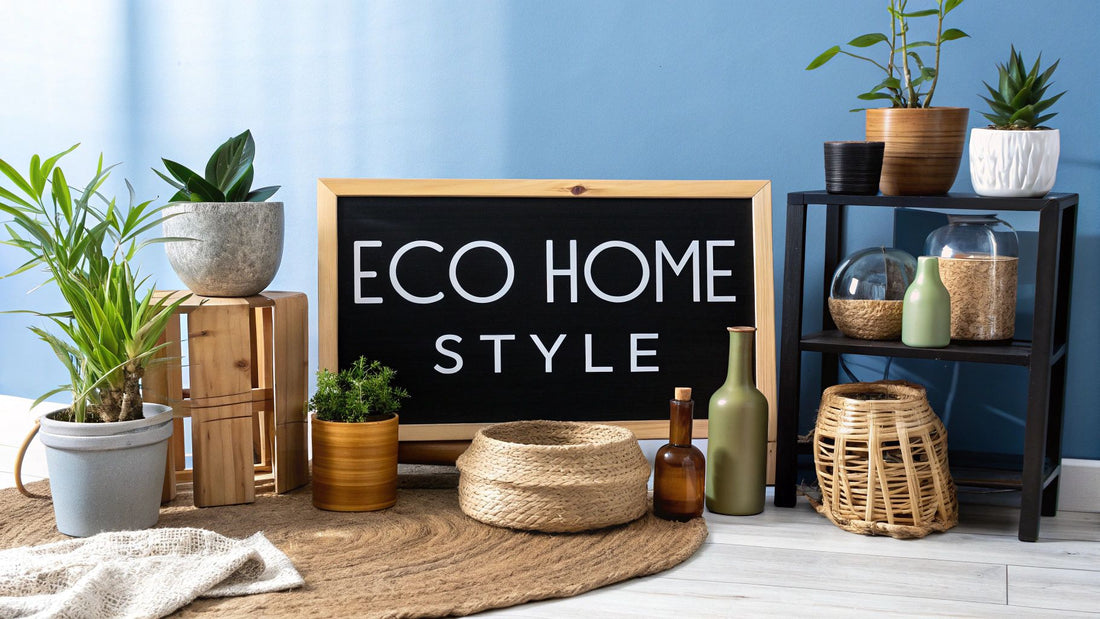
Eco Friendly Home Accessories for Sustainable Style
Share
Eco-friendly home accessories are more than just beautiful objects. They’re thoughtfully designed pieces that minimize their environmental footprint from start to finish—through their materials, production, and entire lifecycle. They represent the perfect blend of style and sustainability, letting you craft a space that’s not just stunning but also kind to the planet.
Why Sustainable Decor Is More Than Just a Trend
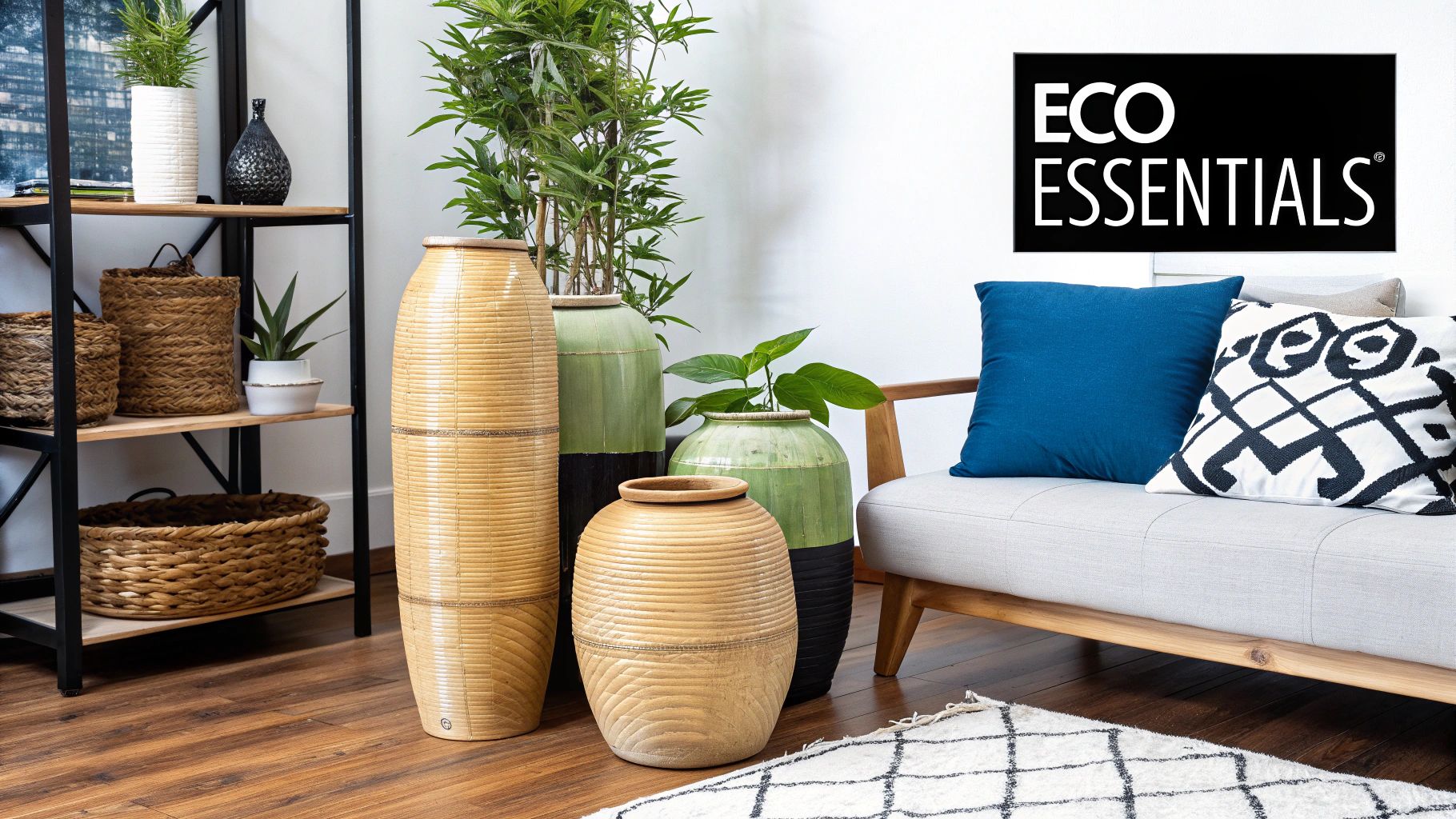
Ever find yourself wanting to refresh your living space, but you hesitate, thinking about the potential waste new items might generate? That feeling is part of a much bigger shift in how we think about our homes. We're moving away from fleeting styles and toward creating spaces that feel good, both in how they look and what they stand for.
Choosing eco-friendly home accessories is about making a conscious choice for a healthier home and a healthier planet. It’s not just a passing fad; it's a deep-rooted change in what we value. The market reflects this, too—the global sustainable home decor market is expected to jump from about $388.7 billion in 2024 to $663.9 billion by 2034.
What Makes an Accessory Truly Eco-Friendly?
So, what elevates a simple vase or throw pillow into the "eco-friendly" category? It all comes down to its entire journey, from raw material to its final days in your home.
Think of it this way: a conventional accessory is often like a paper party cup—made for a moment, with little thought about where it came from or where it's going. An eco-friendly accessory, on the other hand, is like a favorite handcrafted ceramic mug. It’s made with care from natural materials, built to last, and beautiful enough to be cherished for years.
An item’s sustainability is determined by its entire lifecycle—from responsibly sourced materials and ethical production to its potential for being recycled, repurposed, or composted at the end of its use.
Key Elements of Sustainable Decor
To make choices you feel good about, it helps to know what to look for. The undeniable importance of eco-friendly products in 2025 and beyond is built on a few core ideas. Keep an eye out for accessories that have these qualities:
- Responsible Materials: They’re crafted from renewable resources like bamboo, cork, or reclaimed wood, or made from recycled materials like glass and metal.
- Ethical Production: The making-of process minimizes pollution, waste, and energy use. It also means fair wages and safe working conditions for the artisans and workers behind the product.
- Durability and Longevity: These pieces are built to last. Quality craftsmanship reduces the need for constant replacements, which in turn cuts down on landfill waste.
- Non-Toxic Finishes: They use low-VOC (volatile organic compounds) paints, natural dyes, and chemical-free finishes, which makes the air inside your home healthier to breathe.
By focusing on these elements, you can curate a home that isn’t just stylish, but is a genuine reflection of your values.
Understanding The Best Sustainable Materials
Choosing eco-friendly home accessories really comes down to one thing: knowing what they’re made of. At first, the world of sustainable materials can feel a little overwhelming, but it gets much simpler when you start thinking of them in categories. Each group has its own personality, offering different textures, styles, and, of course, environmental perks for your home.
Let's break them down into three main families: fast-growing naturals, upcycled treasures, and organic textiles. Thinking this way makes it so much easier to spot the genuinely good stuff and appreciate the story behind each piece.
Fast Growing Naturals
Think of this category as nature’s overachievers. These are plant-based materials that grow at a ridiculously fast pace, all while sipping minimal resources like water and needing no pesticides or fertilizers. Their speedy growth cycle makes them a fantastic, renewable alternative to slower-growing woods.
Bamboo is the poster child here—it’s like nature’s skyscraper. Some species can shoot up an astonishing three feet in a single day, making it one of the most renewable resources we have. It’s also incredibly strong and versatile, showing up in everything from cutting boards to small furniture. Then there’s cork, which is harvested from the bark of cork oak trees without ever harming the tree. The bark simply regenerates every nine years. Pretty clever, right?
Upcycled Treasures
Upcycled materials are the storytellers of the decor world. These are items that have been given a second chance at life, transformed from what was once considered junk into something beautiful and new. This process is a huge win for the planet—it keeps waste out of landfills and saves the energy and raw materials needed to create something from scratch.
You’ll find these transformed materials everywhere in home accessories:
- Reclaimed Wood: Pulled from old barns, factories, or even ships, every piece of reclaimed wood has a past. It adds instant soul to picture frames, shelves, and decorative bowls.
- Recycled Glass: Old bottles and jars are melted down and reformed into stunning new vases, tumblers, and light fixtures. They often have a unique, subtle tint that you just can't replicate.
- Recycled Metals: Aluminum and steel can be recycled over and over again without ever losing their quality. You’ll see them pop up as decorative sculptures, planters, and minimalist candle holders.
By choosing upcycled items, you're not just decorating your home; you're participating in a circular economy that values resources and minimizes waste.
Organic Textiles
Textiles are what soften a space, adding that crucial layer of warmth and texture. When it comes to sustainability, that "organic" label is everything. It’s your guarantee that the fibers were grown without synthetic pesticides or nasty chemicals. This keeps our soil healthy, our water clean, and protects the farmers who grow them.
This infographic gives a great snapshot of why choosing these materials matters.
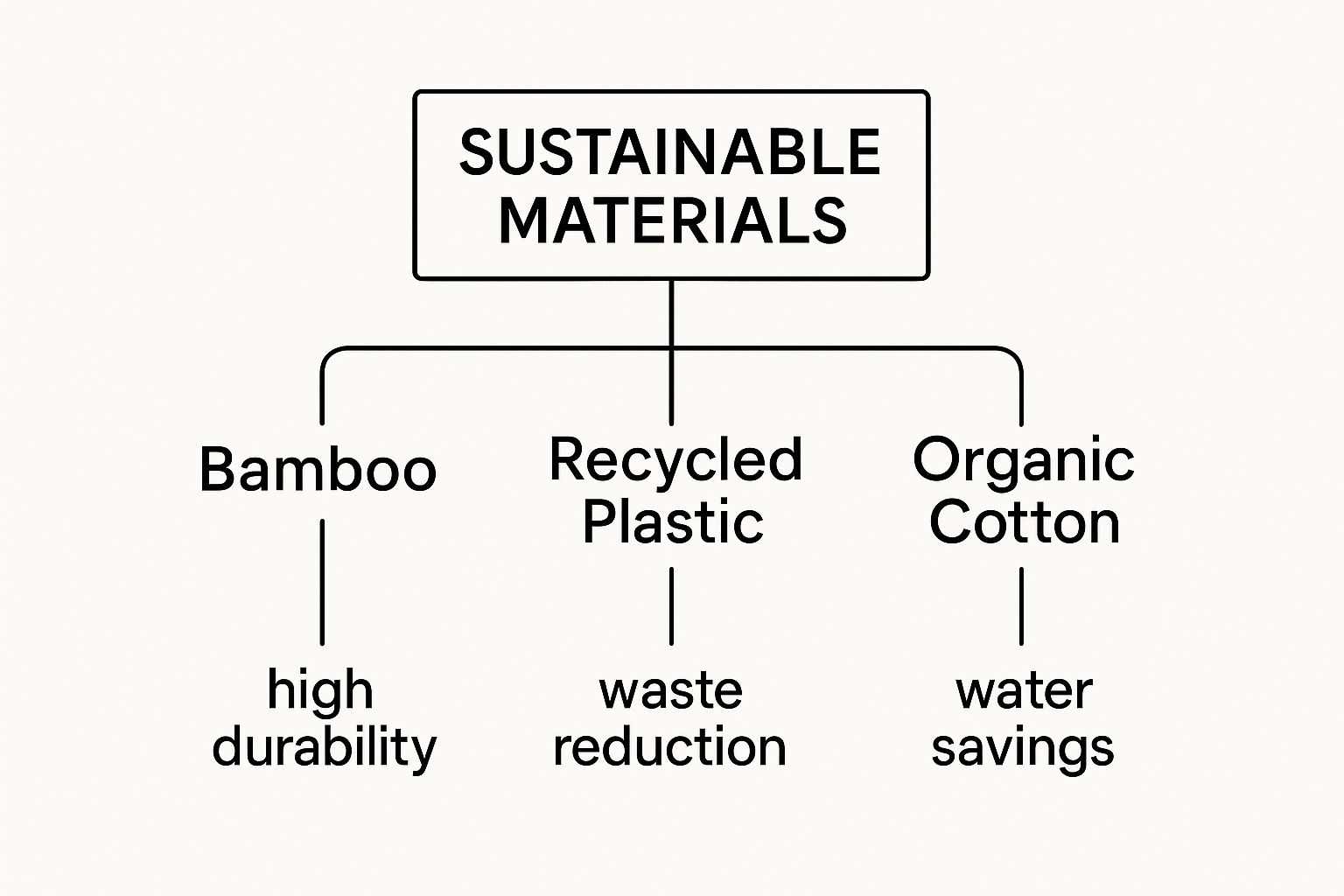
As you can see, it links materials like bamboo and organic cotton directly to their biggest environmental benefits, like durability and water conservation.
Organic cotton is a perfect example, as it needs way less water to grow than its conventional cousin. You’ll find it in cozy throw blankets, cushion covers, and soft bath linens. Another star is jute, a tough, coarse fiber that’s perfect for area rugs, stylish storage baskets, and macrame wall hangings. It brings an instant natural, earthy vibe to any room, proving that you never have to sacrifice comfort for sustainability.
To make things even clearer, here’s a quick comparison of some of the most common materials you'll encounter.
A Quick Guide to Eco Friendly Materials
This table offers a simple, at-a-glance look at common sustainable materials. Use it to quickly understand their key benefits and see how they might fit into your home decor.
| Material | Key Benefit | Common Accessories |
|---|---|---|
| Bamboo | Extremely fast-growing and renewable | Kitchen utensils, small furniture, bathroom accessories |
| Cork | Harvested without harming the tree | Coasters, placemats, bulletin boards, flooring |
| Reclaimed Wood | Reduces waste and has a unique history | Picture frames, shelving, decorative trays, mirror frames |
| Recycled Glass | Diverts waste from landfills and saves energy | Vases, drinking glasses, candle holders, light fixtures |
| Organic Cotton | Grown without pesticides; uses less water | Throw blankets, pillows, towels, curtains, bedding |
| Jute | Highly durable, biodegradable, and affordable | Rugs, baskets, tote bags, wall hangings |
Hopefully, this little cheat sheet helps you feel more confident as you start spotting these materials out in the wild. Each one offers a unique way to make your home more beautiful and a little kinder to the planet.
The Real Payoff of Eco-Conscious Decor
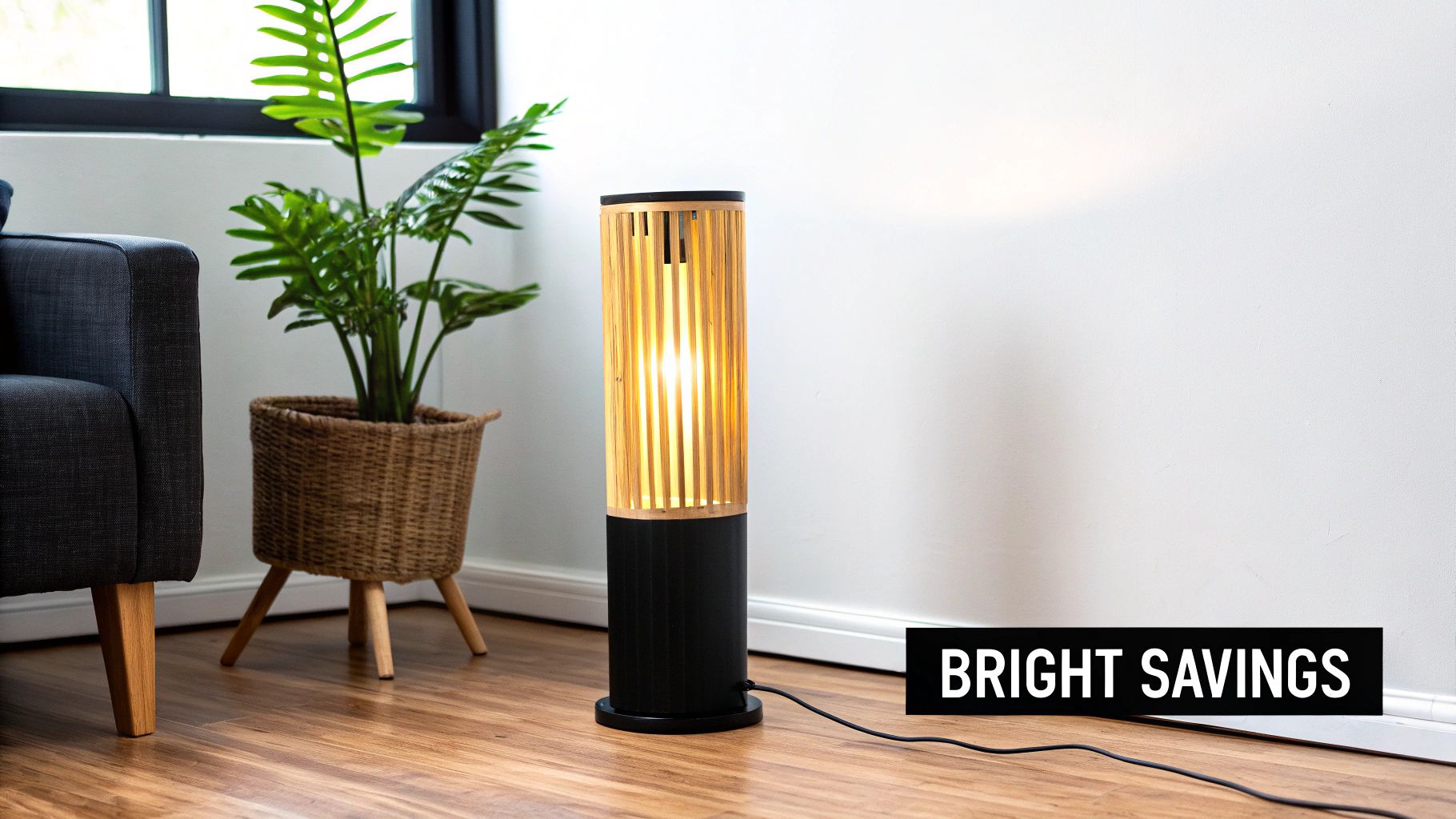
Choosing eco-friendly home accessories is about so much more than just a nod to the planet; it brings real, tangible advantages right into your home. These aren't abstract concepts. We're talking about benefits that can transform your house from a simple structure into a sanctuary that genuinely supports your well-being, reflects what you stand for, and can even save you money down the road.
This move toward more mindful consumption isn't happening in a vacuum. It’s a huge driver in the home decor market, which hit a staggering $747.75 billion in 2024 and is expected to climb past $1 trillion by 2032. As more of us put sustainability on our priority list, the demand for accessories that deliver these personal perks just keeps growing. You can dive deeper into these market trends and what’s fueling them over at fortunebusinessinsights.com.
Creating a Healthier Home Environment
It’s an unsettling thought, but many conventional home decor items are quietly releasing volatile organic compounds (VOCs) into your air. These chemicals, often found in paints, synthetic fabrics, and certain manufactured woods, are linked to things like headaches and respiratory issues. It’s like having a slow, invisible pollutant leaking into your personal space.
Eco-friendly accessories, on the other hand, are almost always made with non-toxic materials and finished with natural or low-VOC paints and dyes. By making this simple switch, you're actively cleaning up your home's air quality. You’re creating a safer, healthier space where you and your family can literally breathe easier.
Investing in Lasting Quality and Timeless Style
In a world filled with fast furniture and trends that evaporate in a season, sustainable decor is built differently. These pieces are typically crafted with better materials and a much greater eye for detail—they’re designed for durability, not disposability. That focus on quality means you won’t be replacing them nearly as often.
Opting for well-made, sustainable pieces is an investment in longevity. You save money in the long run by avoiding the cycle of buy, break, and replace that defines so many mass-produced goods.
Instead of chasing what's hot right now, eco-conscious decor often leans into timeless designs that look great for years. A beautiful, handcrafted wooden bowl or a handwoven jute rug has an enduring appeal that just doesn't fade with the next trend cycle, adding a layer of classic elegance to your home.
Championing Artisan Communities
A lot of eco-friendly home accessories aren't churned out by massive factories. They're handcrafted by skilled artisans from communities all over the globe. When you buy one of these items, your money is often going directly toward supporting a small business and preserving traditional craft skills passed down through generations.
Each piece tells a story—of the person who made it, the place it came from, and the natural materials that form it. This adds a depth of meaning and character to your decor that you’ll never find on a factory line. Your choices empower real people, sustain local economies, and fill your home with objects that have a genuine soul.
How to Choose Truly Sustainable Accessories
Navigating the world of eco-friendly home accessories can feel like a pop quiz you didn’t study for. With so many brands making green claims, how do you separate the genuinely sustainable from the clever marketing? The key is to become a more conscious consumer, armed with a simple checklist to help you make choices that truly align with your values.
This means looking past the pretty surface of a product and digging a little deeper into its story. Think of yourself as a detective for good. Instead of taking claims at face value, you're looking for the clues that prove an item is as kind to the planet as it is beautiful.
Read the Labels Like a Pro
The fastest way to get a real sense of a product's eco-credentials is to look for third-party certifications. These labels are like a seal of approval from trusted organizations that have already done the hard work of vetting a product's entire lifecycle. Honestly, they take most of the guesswork out of your purchase.
Here are a few of the most reliable certifications to keep on your radar:
- Forest Stewardship Council (FSC): When you see this on wood or paper products, it’s a guarantee. It means the material was sourced from a responsibly managed forest that protects biodiversity and local communities.
- Global Organic Textile Standard (GOTS): This is the gold standard for textiles like cotton and linen. It ensures the fibers are certified organic and that the entire production process—from dyeing to finishing—is environmentally and socially responsible.
- Fair Trade Certified: This label focuses on the human element. It confirms that the artisans and workers who made the product received fair wages and work in safe conditions, empowering their communities.
Look Beyond the Product Itself
A truly sustainable brand doesn't just sell eco-friendly products; it operates with a green mindset through and through. This just requires a quick investigation into the company's mission and practices. Does their website talk openly about their supply chain? Do they share details about their manufacturing or their commitment to ethical labor?
Transparency is a hallmark of a trustworthy brand. Companies that are proud of their sustainable practices are usually eager to share the details with you. Vague language or a lack of information can be a red flag for "greenwashing."
This ethos of transparency extends to all sorts of products. For example, when you're exploring options like sustainable bag brands, you'll notice the most reputable companies are crystal clear about their materials and production methods. You should apply this same investigative lens to your home accessories.
Prioritize Function and Versatility
One of the most powerful—and often overlooked—aspects of sustainable living is simply buying less. By choosing high-quality, versatile items, you naturally reduce waste and consumption over time. Before you make a purchase, ask yourself a few key questions.
Can this item serve more than one purpose? A beautiful ceramic pitcher could just as easily be a vase for flowers, a utensil holder, or, of course, a vessel for serving drinks. Does this piece have a timeless design that will outlast fleeting trends? A classic woven basket or a simple reclaimed wood frame will likely fit your style for years to come, reducing the urge to replace it next season.
Investing in adaptable, durable pieces is a core principle of creating a truly sustainable home.
How to Style Your Home Sustainably
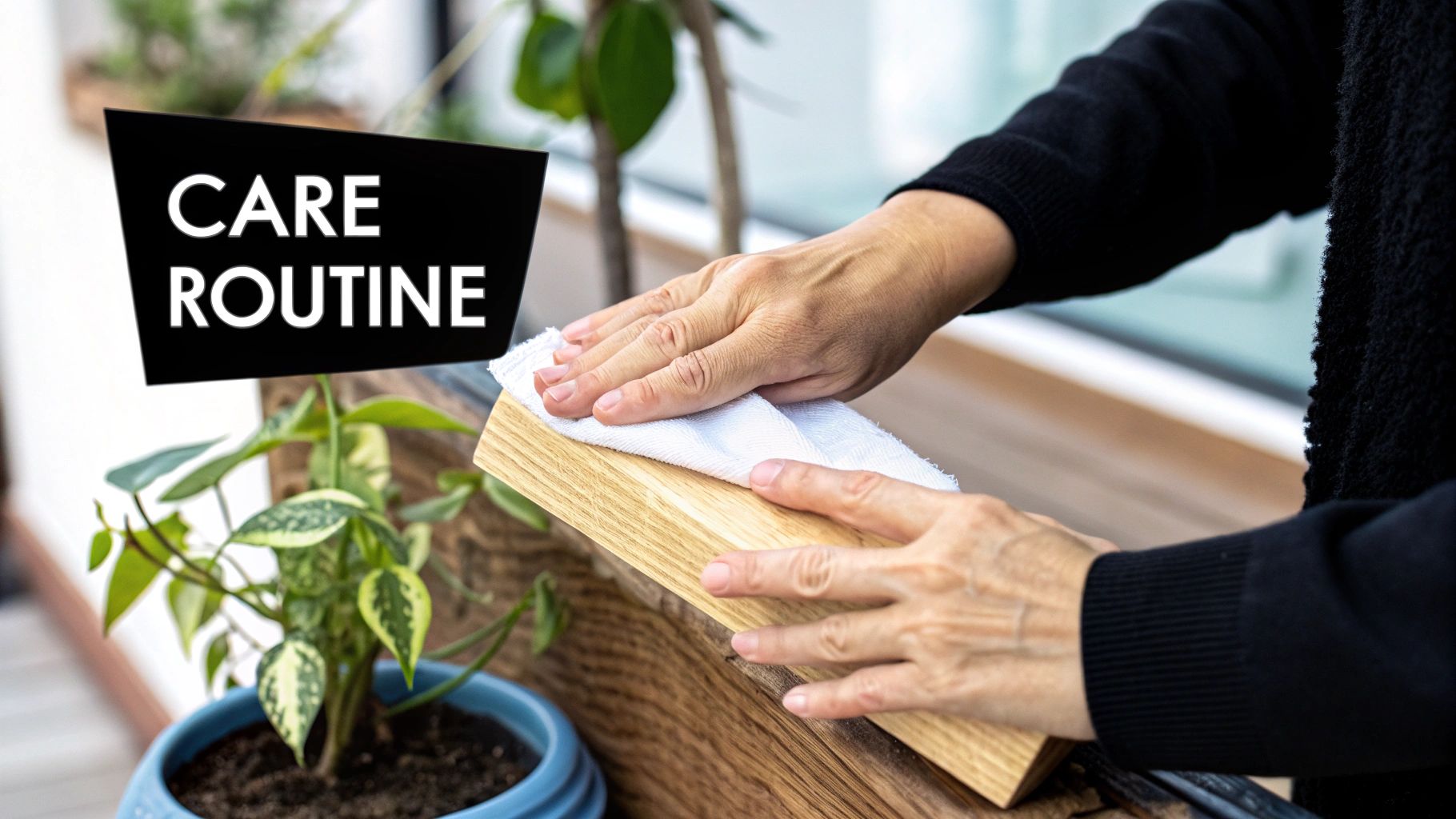
Bringing eco-friendly accessories into your home isn't about following a strict set of rules. Think of it as a creative process. No matter your personal style—from sleek and modern to warm and rustic—sustainable pieces can elevate your space by adding texture, character, and a real sense of purpose. The key is to find materials and forms that feel like a natural extension of what you already love.
It’s like adding a new, meaningful ingredient to your favorite recipe. You're not changing the dish; you're just making it richer and more satisfying. This desire for decor with a story is catching on. Just look at the eco-friendly furniture market, a close cousin to accessories, which was valued at a whopping $43.26 billion in 2022 and is on track to nearly double by 2030. It's clear people are hungry for more than just aesthetics.
Creating a Modern and Minimal Look
If you're a fan of clean lines and uncluttered spaces, sustainable accessories can bring in a touch of warmth without creating visual noise. The focus here is on simple forms and honest, beautiful materials.
- Recycled Metal Sculptures: A single, sleek sculpture made from recycled steel or aluminum can be a stunning focal point on a console table or bookshelf, adding interest without the clutter.
- Organic Linen Throws: The naturally rumpled texture of an organic linen throw blanket draped over a sofa is perfect for softening sharp angles and adding a bit of effortless comfort.
- Cork Coasters and Placemats: Simple, geometric cork accessories have an earthy tone that fits perfectly into a minimalist dining setup. They get the job done beautifully and quietly.
Achieving a Warm and Rustic Feel
For those whose style leans more towards cozy, lived-in, and natural, eco-friendly accessories are an obvious match. This look is all about celebrating the beautiful imperfections and history found in reclaimed materials. It's an invitation to layer different textures and create a rich, welcoming vibe.
Start with something like reclaimed wood shelves—every knot and grain pattern tells a story. Use them to show off a collection of hand-thrown pottery, where the slight variations in shape and glaze add an artisanal character that mass-produced items just can't replicate. If this sounds like your kind of space, you can find more inspiration in our handpicked collection of eco-friendly home and living accessories.
By layering different natural textures—like a rough-hewn wooden tray on a smooth jute runner—you create a space that feels collected and authentic, not just decorated.
The Power of Secondhand Finds
At the end of the day, the most sustainable accessory is one that already exists. Hitting up thrift stores, antique shops, and online marketplaces is an incredible way to discover one-of-a-kind pieces that have zero environmental impact from new production.
This path also swings the door wide open for simple DIY projects. That old, ornate picture frame you found? Give it a modern twist with a quick coat of low-VOC chalk paint. A random collection of glass jars can become chic, uniform storage for your pantry or bathroom with a new set of bamboo lids. These small, creative moves not only save you money but also infuse your home with a personality that is uniquely yours.
Common Questions About Sustainable Decor
Diving into the world of sustainable decor can feel a little like learning a new language. It's exciting, but it's totally natural to have a few questions before you feel confident in your choices. Let's clear up some of the most common uncertainties to get you started on your journey.
Are Eco-Friendly Home Accessories Always More Expensive?
This is one of the biggest myths out there—that choosing sustainably will always hit your wallet harder. While it's true some artisan-made pieces carry a higher price tag to reflect fair wages and incredible materials, that's not the whole story. It's better to think of it less as an expense and more as a long-term investment.
An eco-friendly item is usually built to last, which saves you from the cycle of repeat purchases that comes with "fast decor." Plus, its timeless style means it won’t look dated next season. On top of that, embracing sustainability fully can open up some incredibly affordable options. Thrifting secondhand treasures or trying a simple DIY upcycling project are often the most budget-friendly and planet-friendly choices you can make.
How Can I Spot Greenwashing and Find Brands I Can Trust?
"Greenwashing" is a sneaky marketing tactic where a company makes vague or misleading claims to seem more environmentally friendly than it actually is. To avoid getting duped, you need to become a bit of a detective. Look for clear evidence, not just fluffy, feel-good language.
Here’s what to look for:
- Red Flags: Be wary of broad, unsupported claims like "all-natural" or "eco-friendly" without any proof to back them up. A lack of transparency about where or how their products are made is another major warning sign.
- Green Lights: Trustworthy brands are transparent. They'll show you specific, recognized certifications like FSC for wood or GOTS for textiles. They're proud to share details about their supply chain, materials, and ethical production practices.
A truly sustainable brand is an open book about its entire process, from sourcing raw materials to shipping the final product. They don’t just tell you they're green—they show you.
What Are The Easiest First Swaps I Can Make?
The thought of overhauling your entire home is overwhelming, so here's a secret: don't! The best approach is to start with small, simple swaps that make a surprisingly big impact over time. These easy first steps build momentum and show you just how simple sustainable living can be.
A great place to start is the kitchen. It's a high-traffic area where little changes really add up. Here are a few effortless ideas to get you started:
- Switch to Organic Cotton Dish Towels: This is an easy one-for-one replacement that immediately eliminates pesticides from your daily routine.
- Buy a Set of Recycled Glassware: Making recycled glass uses way less energy than creating new glass, and it adds such a unique character to your table.
- Add a Cork Trivet or Coasters: Cork is a wonderfully renewable resource. It's harvested without ever harming the tree, making it a perfect eco-friendly material for protecting your surfaces.
These simple swaps are proof that choosing sustainable decor doesn't have to be some grand, complicated gesture. It all starts with one thoughtful choice at a time.
Ready to discover beautiful, mindfully made pieces for your home? Explore the curated collection at The Simple Discipline and find unique accessories that align with your style and values. https://thesimpled.com
Article created using Outrank